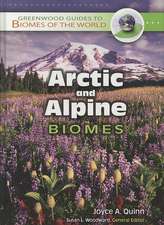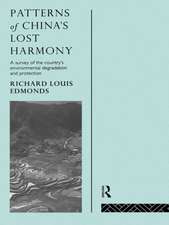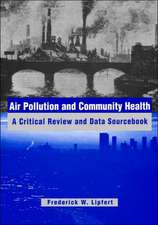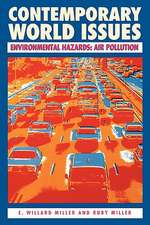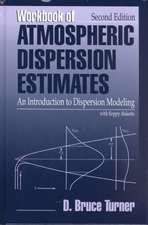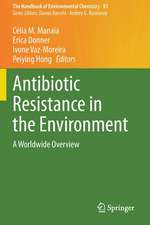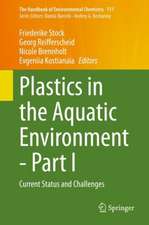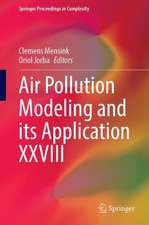Air Pollution Modeling and its Application XXVI: Springer Proceedings in Complexity
Editat de Clemens Mensink, Wanmin Gong, Amir Hakamien Limba Engleză Hardback – 24 noi 2019
This work is a collection of selected papers presented at the 36th International Technical Meeting on Air Pollution Modeling and its Application, held in Ottawa, Canada, May 14-18, 2018.
The book is intended as reference material for students and professors interested in air pollution modeling at the graduate level as well as researchers and professionals involved in developing and utilizing air pollution models.
| Toate formatele și edițiile | Preț | Express |
|---|---|---|
| Paperback (1) | 1119.38 lei 6-8 săpt. | |
| Springer International Publishing – 24 noi 2020 | 1119.38 lei 6-8 săpt. | |
| Hardback (1) | 1125.55 lei 6-8 săpt. | |
| Springer International Publishing – 24 noi 2019 | 1125.55 lei 6-8 săpt. |
Din seria Springer Proceedings in Complexity
- 20%
 Preț: 1128.80 lei
Preț: 1128.80 lei - 18%
 Preț: 1240.16 lei
Preț: 1240.16 lei - 18%
 Preț: 1214.09 lei
Preț: 1214.09 lei -
 Preț: 497.13 lei
Preț: 497.13 lei - 18%
 Preț: 1112.30 lei
Preț: 1112.30 lei - 18%
 Preț: 1300.10 lei
Preț: 1300.10 lei - 20%
 Preț: 1084.83 lei
Preț: 1084.83 lei - 18%
 Preț: 1393.27 lei
Preț: 1393.27 lei - 18%
 Preț: 961.55 lei
Preț: 961.55 lei - 20%
 Preț: 646.95 lei
Preț: 646.95 lei - 15%
 Preț: 641.71 lei
Preț: 641.71 lei - 18%
 Preț: 1395.32 lei
Preț: 1395.32 lei - 18%
 Preț: 952.89 lei
Preț: 952.89 lei - 20%
 Preț: 646.12 lei
Preț: 646.12 lei - 20%
 Preț: 571.27 lei
Preț: 571.27 lei - 20%
 Preț: 1288.76 lei
Preț: 1288.76 lei - 15%
 Preț: 643.34 lei
Preț: 643.34 lei - 18%
 Preț: 947.04 lei
Preț: 947.04 lei - 24%
 Preț: 839.38 lei
Preț: 839.38 lei - 18%
 Preț: 1251.98 lei
Preț: 1251.98 lei - 18%
 Preț: 1670.11 lei
Preț: 1670.11 lei - 18%
 Preț: 1223.25 lei
Preț: 1223.25 lei - 18%
 Preț: 974.04 lei
Preț: 974.04 lei - 15%
 Preț: 646.11 lei
Preț: 646.11 lei - 18%
 Preț: 1225.16 lei
Preț: 1225.16 lei - 15%
 Preț: 645.79 lei
Preț: 645.79 lei - 18%
 Preț: 957.32 lei
Preț: 957.32 lei - 20%
 Preț: 984.18 lei
Preț: 984.18 lei - 15%
 Preț: 643.84 lei
Preț: 643.84 lei - 15%
 Preț: 644.63 lei
Preț: 644.63 lei - 18%
 Preț: 1236.51 lei
Preț: 1236.51 lei - 18%
 Preț: 1223.25 lei
Preț: 1223.25 lei - 18%
 Preț: 964.86 lei
Preț: 964.86 lei - 18%
 Preț: 1278.82 lei
Preț: 1278.82 lei - 18%
 Preț: 1217.41 lei
Preț: 1217.41 lei - 24%
 Preț: 1067.23 lei
Preț: 1067.23 lei -
 Preț: 424.99 lei
Preț: 424.99 lei - 18%
 Preț: 1236.69 lei
Preț: 1236.69 lei - 20%
 Preț: 1277.57 lei
Preț: 1277.57 lei -
 Preț: 424.81 lei
Preț: 424.81 lei - 24%
 Preț: 1084.90 lei
Preț: 1084.90 lei
Preț: 1125.55 lei
Preț vechi: 1372.62 lei
-18% Nou
Puncte Express: 1688
Preț estimativ în valută:
215.37€ • 224.86$ • 178.25£
215.37€ • 224.86$ • 178.25£
Carte tipărită la comandă
Livrare economică 04-18 aprilie
Preluare comenzi: 021 569.72.76
Specificații
ISBN-13: 9783030220549
ISBN-10: 3030220540
Pagini: 456
Ilustrații: XLVII, 490 p. 177 illus., 162 illus. in color.
Dimensiuni: 155 x 235 mm
Greutate: 0.93 kg
Ediția:1st ed. 2020
Editura: Springer International Publishing
Colecția Springer
Seria Springer Proceedings in Complexity
Locul publicării:Cham, Switzerland
ISBN-10: 3030220540
Pagini: 456
Ilustrații: XLVII, 490 p. 177 illus., 162 illus. in color.
Dimensiuni: 155 x 235 mm
Greutate: 0.93 kg
Ediția:1st ed. 2020
Editura: Springer International Publishing
Colecția Springer
Seria Springer Proceedings in Complexity
Locul publicării:Cham, Switzerland
Cuprins
Preface.- Scientific Committee.- History of ITM.- List of Participants.- Part I: Regional and Intercontinental Modelling.- Part II: Local and Urban Scale Modeling.- Part III: Emission Modeling and Processing.- Part IV: Data Assimilation and Air Quality Forecasting.- Part V: Model Assessment and Verification.- Part VI: Aerosols in the Atmosphere.- Part VII: Modeling Air Pollution in a Changing Climate.- Part VIII: Air Quality Effects on Human Health and Ecology.- Part IX: Special Sessions.
Notă biografică
Dr Clemens Mensink is head of the environmental modelling unit at VITO in Belgium. The unit employs 85 researchers, ICT professionals and technicians. It develops, improves and implements methodologies and computer models to estimate the impact of human activities on air, water and soil quality in a spatial context. Clemens received his PhD (1992) and a post graduate degree (1988) in fluid dynamics from the Von Karman Institute in Belgium. He studied chemical engineering, fluid mechanics and numerical mathematics, and received his MSc (1987) in mechanical engineering from University of Twente in the Netherlands. In 1998 he received the ENERO prize. Clemens is currently president of the International Technical Meeting on Air Pollution Modelling and its Applications. He is an expert in air pollution modelling and author of more than 80 peer-reviewed publications in international journals. He is lecturing air pollution modelling at Ghent University (postgraduate studiesin weather and climate modelling) and University of Hasselt.
Wanmin Gong is a research scientist at the Atmospheric Science and Technology Directorate, Science and Technology Branch, Environment and Climate Change Canada, located in Toronto, Ontario. He received his B.Sc. from the Nanjing Institute of Meteorology, P. R. China, and his Ph.D. from the University of Reading, U.K. His main research area is in regional air quality modelling, including model development and evaluation, with a focus on cloud processing and interaction with atmospheric tracers. For this purpose he used an on-line, fully coupled, air quality forecast model to investigate the impact of cloud-aerosol interaction on weather and air quality. More recently, his research activities are focused on the development of air quality modeling capability for the Arctic and Canada’s northern region and the investigation, in conjunction with field observations, the sources and processes affectingthe Arctic atmospheric composition and their impact on the Arctic environment and climate.
Amir Hakami is an Associate Professor in the Department of Civil and Environmental Engineering at Carleton University in Ottawa, Canada. He joined Carleton University after receiving his Ph.D. from Georgia Institute of Technology in 2003 and completing postdoctoral work at Caltech in 2007. His expertise is in the general area of air quality modeling, with specialization in development and applications of air pollution sensitivity
analysis tools and models. Dr. Hakami’s current research foci include air pollution health effects estimation, air pollution economics, decision support systems, uncertainty analysis, inverse modeling, satellite remote sensing of air quality, and long-range transport of pollution. During the last 18 years, Dr. Hakami has made significant contributions to development of sensitivity analysis and probing tools for air quality models in general, and for the USEPA’s CMAQ model in particular. He is the lead researcher for implementing adjoint sensitivity analysis method in CMAQ and has previously developed the high-order direct decoupled method (HDDM) for sensitivity analysis which was later implemented in CMAQ and CAMx.
Textul de pe ultima copertă
Current developments in air pollution modeling are explored as a series of contributions from researchers at the forefront of their field. This newest contribution on air pollution modeling and its application is focused on local, urban, regional and intercontinental modeling; emission modeling and processing; data assimilation and air quality forecasting; model assessment and evaluation; atmospheric aerosols. Additionally, this work also examines the relationship between air quality and human health and the effects of climate change on air quality.
This work is a collection of selected papers presented at the 36th International Technical Meeting on Air Pollution Modeling and its Application, held in Ottawa, Canada, May 14-18, 2018.
The book is intended as reference material for students and professors interested in air pollution modeling at the graduate level as well as researchers and professionals involved in developing and utilizing air pollutionmodels.
This work is a collection of selected papers presented at the 36th International Technical Meeting on Air Pollution Modeling and its Application, held in Ottawa, Canada, May 14-18, 2018.
The book is intended as reference material for students and professors interested in air pollution modeling at the graduate level as well as researchers and professionals involved in developing and utilizing air pollutionmodels.
Caracteristici
Presenting latest research results from top researchers in the field Providing a perfect balance between applied and theoretical results Covering worldwide developments?


